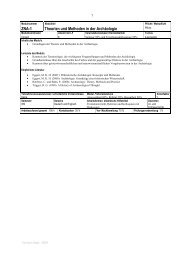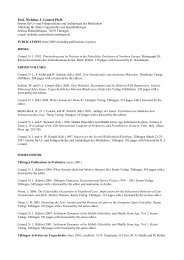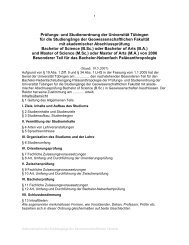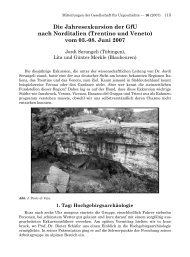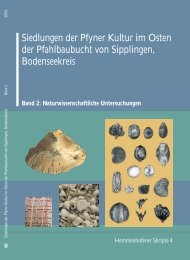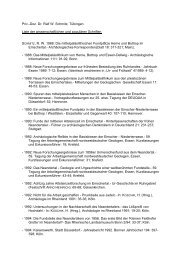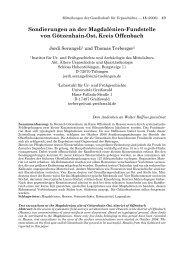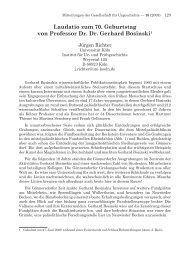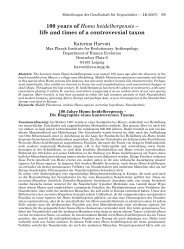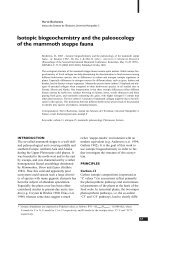bronze age environment and economy in the troad - Universität ...
bronze age environment and economy in the troad - Universität ...
bronze age environment and economy in the troad - Universität ...
You also want an ePaper? Increase the reach of your titles
YUMPU automatically turns print PDFs into web optimized ePapers that Google loves.
chapter 2: methods<br />
2 Methods<br />
2.1 From sampl<strong>in</strong>g to species list<br />
2.1.1 Sampl<strong>in</strong>g <strong>and</strong> recovery<br />
The methodology of sampl<strong>in</strong>g was a popular subject at <strong>the</strong> end<br />
of <strong>the</strong> 1970s <strong>and</strong> beg<strong>in</strong>n<strong>in</strong>g of <strong>the</strong> 1980s, <strong>and</strong> enough has been<br />
written about <strong>the</strong> ‛right’ way to sample to give <strong>the</strong> beg<strong>in</strong>ners<br />
options to develop <strong>the</strong>ir own sampl<strong>in</strong>g strategy (e.g. Nesbitt<br />
<strong>and</strong> Samuel 1989, van der Veen <strong>and</strong> Fieller 1982, Mueller<br />
1975).<br />
Archaeobotanists were look<strong>in</strong>g for sampl<strong>in</strong>g strategies<br />
adaptable to all sites to fulfil <strong>the</strong> aim of comparability between<br />
sites, but from <strong>the</strong> literature it becomes quite clear that each<br />
sampl<strong>in</strong>g strategy has to be adapted to <strong>the</strong> conditions on each<br />
excavation. In consequence different sampl<strong>in</strong>g strategies are<br />
usually comb<strong>in</strong>ed with<strong>in</strong> one excavation.<br />
M. Jones (1991) discusses four different sampl<strong>in</strong>g strategies.<br />
‛Haphazard or grab sampl<strong>in</strong>g’ is described as unstrategic <strong>and</strong><br />
passive: differences of structures are not taken <strong>in</strong>to account <strong>and</strong><br />
<strong>the</strong>se unrecognised factors are <strong>in</strong>terpreted as part of <strong>the</strong> data<br />
itself. ‛Haphazard sampl<strong>in</strong>g’ might happen <strong>in</strong> large excavations<br />
with excavators with different levels of experience. However,<br />
today one might assume that such excavations are rare, where<br />
nobody has any idea where or what <strong>the</strong>y are excavat<strong>in</strong>g.<br />
Usually <strong>the</strong>re is some k<strong>in</strong>d of documentation about <strong>the</strong> sample<br />
context. ‛Purposive or judgement sampl<strong>in</strong>g’ is described as <strong>the</strong><br />
most effective sampl<strong>in</strong>g method <strong>in</strong> terms of <strong>in</strong>formation<br />
content, but has <strong>the</strong> danger of be<strong>in</strong>g too presumptuous. It seems<br />
to be <strong>the</strong> most commonly practised sampl<strong>in</strong>g strategy. Who<br />
would ignore <strong>the</strong>ir knowledge about <strong>the</strong> site <strong>in</strong> <strong>the</strong> search for<br />
fur<strong>the</strong>r discoveries ‛Interval sampl<strong>in</strong>g’, conducted with a grid<br />
over <strong>the</strong> excavation surface, is described as dangerous, because<br />
<strong>the</strong>re will be a loss of <strong>in</strong>formation <strong>and</strong> problems <strong>in</strong> separat<strong>in</strong>g<br />
<strong>the</strong> differences with<strong>in</strong> one population from those of <strong>the</strong> surface.<br />
It seems quite unlikely that anybody would only sample with<br />
this method, <strong>and</strong> would neglect all <strong>the</strong> o<strong>the</strong>r f<strong>in</strong>ds from <strong>the</strong><br />
excavation. With <strong>the</strong> ‛probabilistic or r<strong>and</strong>om sampl<strong>in</strong>g’ <strong>the</strong><br />
probability that each unit will be sampled is <strong>the</strong> same. Under<br />
<strong>the</strong> condition that excavators know <strong>in</strong> advance <strong>the</strong> structur<strong>in</strong>g<br />
of <strong>the</strong> whole site <strong>and</strong> can clearly def<strong>in</strong>e all <strong>the</strong> contexts, <strong>the</strong>y<br />
can sample those contexts with r<strong>and</strong>om numbers <strong>and</strong> f<strong>in</strong>ally,<br />
calculate <strong>the</strong> representativeness of <strong>the</strong> samples. Patterns might<br />
be accidental, however, <strong>and</strong> if additionally <strong>the</strong> sampl<strong>in</strong>g rate is<br />
low, this method can also lead to mis<strong>in</strong>terpretation. When<br />
‛r<strong>and</strong>om sampl<strong>in</strong>g’ is applied <strong>and</strong> previous knowledge<br />
neglected, one might not sample <strong>the</strong> most important contexts <strong>in</strong><br />
terms of <strong>the</strong> actual broadness of <strong>the</strong> species spectrum (van der<br />
Veen 1983). A pattern like <strong>the</strong> one Jones used for his<br />
<strong>in</strong>terpretation of ‛consumer’ <strong>and</strong> ‛producer sites’ might emerge<br />
accidentally. ‛R<strong>and</strong>om sampl<strong>in</strong>g’, <strong>the</strong>refore, is more<br />
appropriate as an additional method ra<strong>the</strong>r than a basic one (M.<br />
Jones 1984).<br />
The only way to exclude accidental patterns is to enlarge <strong>the</strong><br />
cover<strong>age</strong> of <strong>the</strong> sampl<strong>in</strong>g. This latter method seems to be most<br />
commonly used on excavations with large-scale<br />
archaeobiological <strong>in</strong>vestigation. Though <strong>in</strong> most cases it is not<br />
possible to sample <strong>the</strong> whole sediment from a site <strong>and</strong> to<br />
ameliorate representativeness by high cover<strong>age</strong>,<br />
archaeobotanists disagree about which sampl<strong>in</strong>g method<br />
provide samples that are more or less representative for <strong>the</strong><br />
whole site. Some archaeologists assume ‛r<strong>and</strong>om sampl<strong>in</strong>g’<br />
obta<strong>in</strong>s <strong>the</strong> most representative samples for a site (M. Jones<br />
1991), o<strong>the</strong>rs argue that r<strong>and</strong>omly chosen samples are not<br />
representative of <strong>the</strong> whole site, because plant rema<strong>in</strong>s are not<br />
r<strong>and</strong>omly distributed over <strong>the</strong> site (Schaaf 1981), which is an<br />
assumption not many archaeobotanists agree with.<br />
However, it is obvious that large amounts of samples, of large<br />
volume, from <strong>the</strong> widest possible range of contexts, to get a<br />
broad spectrum of species make an <strong>in</strong>vestigation representative<br />
(Jones 1983b, Jacomet, Brombacher <strong>and</strong> Dick 1989).<br />
Between 1991 <strong>and</strong> 1996 a total of 456 botanical samples were<br />
taken at Troy <strong>and</strong> Kumtepe. The material analysed <strong>in</strong>cludes<br />
only <strong>the</strong> 363 samples taken from 1991 to 1995. These are 38<br />
samples from Kumtepe <strong>and</strong> <strong>the</strong> rema<strong>in</strong>der from <strong>the</strong> different<br />
periods of Troy (only those samples with more than 20 items<br />
are listed <strong>in</strong> <strong>the</strong> appendix; for sample location see Map 2).<br />
The sampl<strong>in</strong>g took place under different criteria. The number<br />
of samples from each site (Troy <strong>and</strong> Kumtepe) was partially<br />
related to <strong>the</strong> size of <strong>the</strong> settlements. Includ<strong>in</strong>g <strong>the</strong> Lower City<br />
of <strong>the</strong> Late Bronze Age, Troy measures more than 200000 m²,<br />
while Kumtepe is only about 14000 m². To date, only about<br />
640 m² were excavated <strong>and</strong> sampled at Troy, which makes it<br />
clear that although a lot of sediment was floated for botanical<br />
rema<strong>in</strong>s, <strong>the</strong> representativeness of <strong>the</strong>se samples of <strong>the</strong> whole<br />
site might be questionable. ‛R<strong>and</strong>om sampl<strong>in</strong>g’ always proved<br />
to be <strong>in</strong>compatible with <strong>the</strong> excavation methods at Troy. It<br />
seemed more sensible to rely on <strong>the</strong> excavators’ experience to<br />
def<strong>in</strong>e contexts. To describe <strong>the</strong> sampl<strong>in</strong>g method <strong>in</strong> Troy <strong>and</strong><br />
Kumtepe <strong>in</strong> <strong>the</strong> terms used here, an extended k<strong>in</strong>d of<br />
‛judgement sampl<strong>in</strong>g’ would be <strong>the</strong> most appropriate.<br />
Samples were taken by <strong>the</strong> archaeobotanist, but also by <strong>the</strong><br />
excavators. When samples were taken by <strong>the</strong> excavators, an<br />
<strong>in</strong>struction sheet for sampl<strong>in</strong>g <strong>and</strong> documentation was distributed.<br />
10140 litres of sediment were floated. The sample sizes<br />
were between one <strong>and</strong> 260 litres with a mean of 30 litres,<br />
which is often recommended as a st<strong>and</strong>ard size for botanical<br />
samples. Samples of more than 100 litres were ‛stored’ on big<br />
plastic sheets <strong>and</strong> floated <strong>in</strong> periods of lower ‛sample <strong>in</strong>come’.<br />
Big contexts were also checked for <strong>the</strong>ir homo-or heterogeneity<br />
by section<strong>in</strong>g <strong>the</strong> surface <strong>and</strong> process<strong>in</strong>g <strong>the</strong> sediment separately.<br />
The documentation sheet that came along with <strong>the</strong><br />
samples provided <strong>in</strong>formation <strong>in</strong>clud<strong>in</strong>g <strong>the</strong> date, trench, coord<strong>in</strong>ates,<br />
a context def<strong>in</strong>ition or at least description of features,<br />
dat<strong>in</strong>g (stratigraphic or typological), a sediment description,<br />
<strong>the</strong> sediment volume <strong>and</strong> a rough sketch of <strong>the</strong> location of<br />
<strong>the</strong> sample with<strong>in</strong> <strong>the</strong> excavated area.<br />
In <strong>the</strong> case of large contexts, such as floors, samples were taken<br />
at several different locations, <strong>in</strong> order to determ<strong>in</strong>e whe<strong>the</strong>r<br />
<strong>the</strong>re was any spatial pattern<strong>in</strong>g with<strong>in</strong> <strong>the</strong>se contexts. The<br />
result was ei<strong>the</strong>r that different activity zones could be recognised<br />
(as <strong>in</strong> D8), or that no significant differences over <strong>the</strong> surface<br />
could be detected (as <strong>in</strong> A7), <strong>in</strong> o<strong>the</strong>r words that subsamples<br />
would have been representative of <strong>the</strong> whole context.<br />
These contexts are described <strong>in</strong> chapter 3.<br />
15




